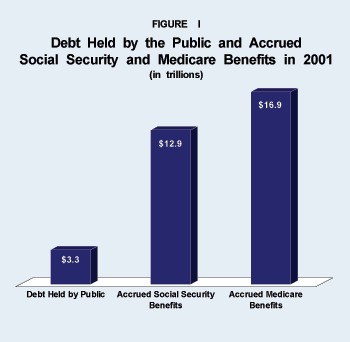Reports about the enormous federal debt abound, as do dire predictions about the impact of that debt on future generations. But just how big is the debt?
If we use the most common definition — the sum total of all outstanding bonds held by the public — the federal government debt stood at $3.3 trillion at the end of 2001. That amounts to $11,657 for each American. However, this explicit debt measure does not reflect the full magnitude of what the government owes. Looming just over the horizon — and wholly ignored by current measures — are the accumulated obligations to pay Medicare and Social Security benefits to the baby boom generation and other current program participants. Although not officially reported as debts, these implicit commitments dwarf the debt held by the public.
- As of 2001, the accumulated entitlement obligations owed to all people (including all current workers) who have earned Social Security and Medicare benefits is $12.9 trillion for Social Security and $16.9 trillion for Medicare. [See Figure I.]
- When these obligations are combined with the debt held by the public, the total burden equals $33.1 trillion, or 10 times the official debt measure.
- This "total debt" is more than three times the size of the nation's total output in 2001, and amounts to $116,381 for every man, woman and child in America.
Measuring the Debt.
The entitlement (or implicit) debt considered in this analysis includes only Social Security and Medicare. It indicates the total value of all the benefits earned up to the present day by each person who has earned benefits from both programs by working in the labor market and paying payroll taxes.
Note that Medicare's accumulated obligations are larger than Social Security's. This might seem unusual to the casual observer, since Social Security annual expenditures for the foreseeable future are larger than the annual expenditures for Medicare. The reason why Medicare obligations exceed Social Security obligations is that it is easier to qualify for Medicare. To qualify for full Medicare benefits, individuals need only contribute for 10 years. By contrast, individuals who contribute to Social Security for 10 years qualify for only minimum Social Security benefits. As individuals work more years – and contribute more taxes – their Social Security benefits increase. The total debt calculation does not anticipate what additional taxes will be paid or benefits earned in the future. Instead, it looks at past earnings and program participation to determine what benefits have been earned up to the present day.
Note also that the liabilities depicted in Figure I are "unfunded" liabilities, in the sense that no funds have been put aside to pay for them. Currently, revenues from the (FICA) payroll tax are used to pay all the expenses of Social Security and some of the expenses of Medicare. When payroll tax revenues have exceeded benefit payments, the surplus has been used to fund other government programs, and more recently to pay down the government's explicit debt. No funds have been put aside to pay for future benefits. Nothing has been invested and nothing has been saved that is dedicated to Social Security and Medicare.
Taxes Needed as Debt Comes Due.
The accrued obligations of both Social Security and Medicare are significant. How will these debts be paid? By 2017, payroll tax revenues collected from workers will not be enough to pay full benefits. Thus, the tax rate needed to support Social Security and Medicare will necessarily grow continuously into the future. Today the payroll tax rate for Social Security retirement and disability insurance is 12.4 percent.
- By the year 2030, when all the baby boomers have reached retirement age, the government will need 16.4 percent of workers' incomes to pay Social Security benefits.
- Add Medicare Part A (primarily hospital bills) and the government's share of Medicare Part B (primarily physicians' fees), and the burden will climb to 24 percent.
- When today's 19-year-olds reach normal retirement age in 2050, their children and grandchildren will face a payroll tax of 17 percent to pay Social Security benefits – that's a 37 percent increase.
- Include Medicare Part A and B and the payroll tax will have to be 28 percent.
Will future taxpayers, many of whom are not yet born, be willing to pay these high tax rates with no assurance that their own benefits will be paid when they retire?
Expected Spending Gap.
Another way to think about the debt is shown in Figure II, which demonstrates how the debt changes over time. This alternative measure nets out future tax payments from anticipated benefits for all program participants in a given year.
It is often noted that the government debt grew substantially during the presidency of Ronald Reagan. This statement is misleading. The explicit public debt did increase between 1980 and 1988 – from 26.1 percent of Gross Domestic Product (GDP) to 40.9 percent. However, based on the alternative measure of Social Security's unfunded obligations, over the same period implicit Social Security debt actually fell – because of the reforms adopted in 1983. As a result, the combined Social Security and explicit government debt fell from 232 percent of GDP in 1980 to 157.5 percent of GDP in 1988. Thus the combined government debt was reduced by 32 percent – almost one-third – during Ronald Reagan's term in office.
During the presidency of George H.W. Bush, the combined debt rose from 156.3 percent to 172.08 percent of GDP. By the end of the Clinton presidency, in 2000, the combined debt had fallen to 135.52 percent of GDP.
Conclusion.
As history shows, promises to fund entitlement benefits are subject to the will of Congress. Yet it is important to keep track of those promises. Measuring implicit entitlement debt serves two important purposes. First, it more accurately shows what promises the federal government has made to current workers and retirees and assigns a cost to the commitments. Second, it clearly demonstrates to policy makers how decisions to increase or decrease entitlement benefits will impact current and future generations.
Andrew J. Rettenmaier is an NCPA senior fellow and the executive associate director of the Private Enterprise Research Center at Texas A&M University. The analysis is based on "Meaningful Measures of Fiscal Deficit and Debt" coauthored with Liqun Liu and Thomas R. Saving.